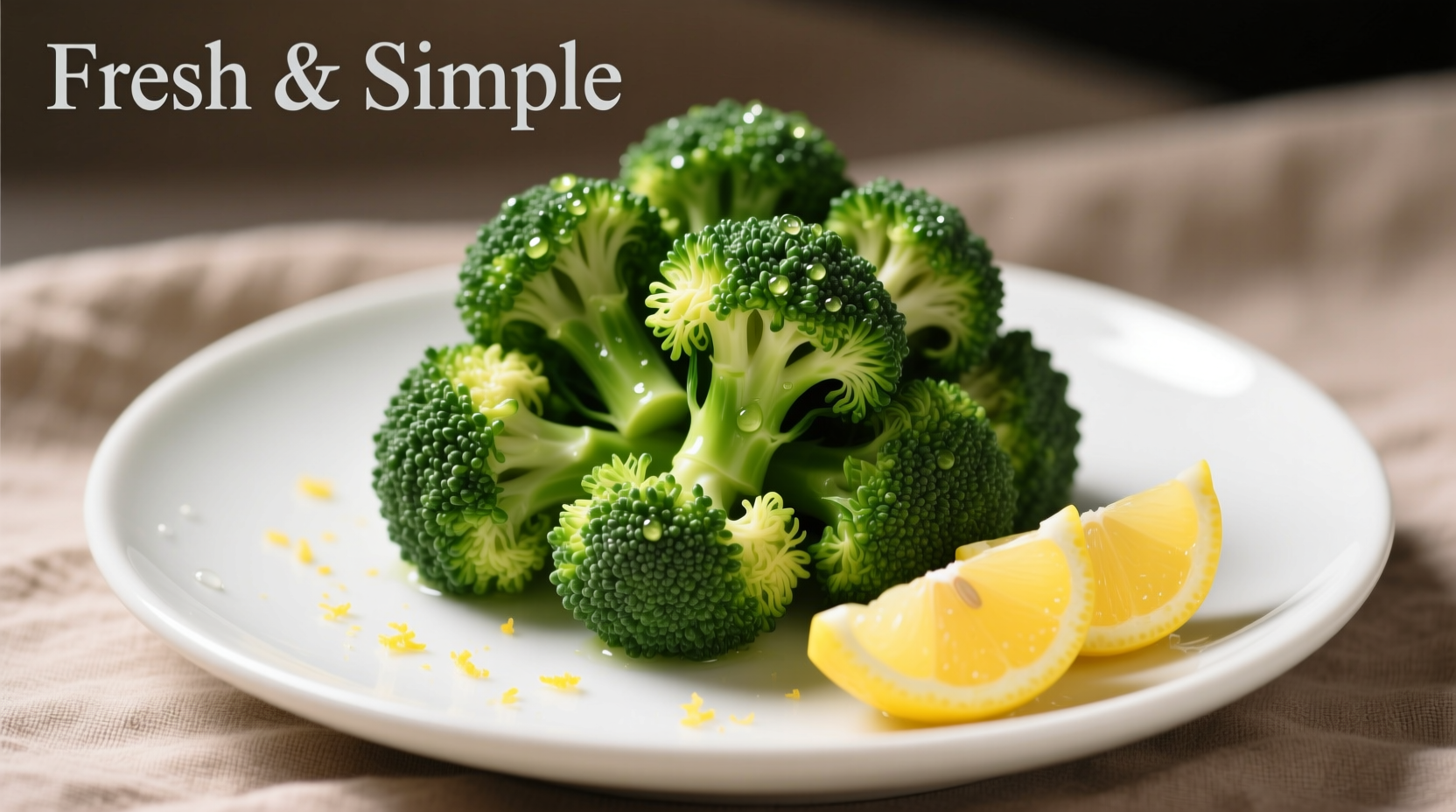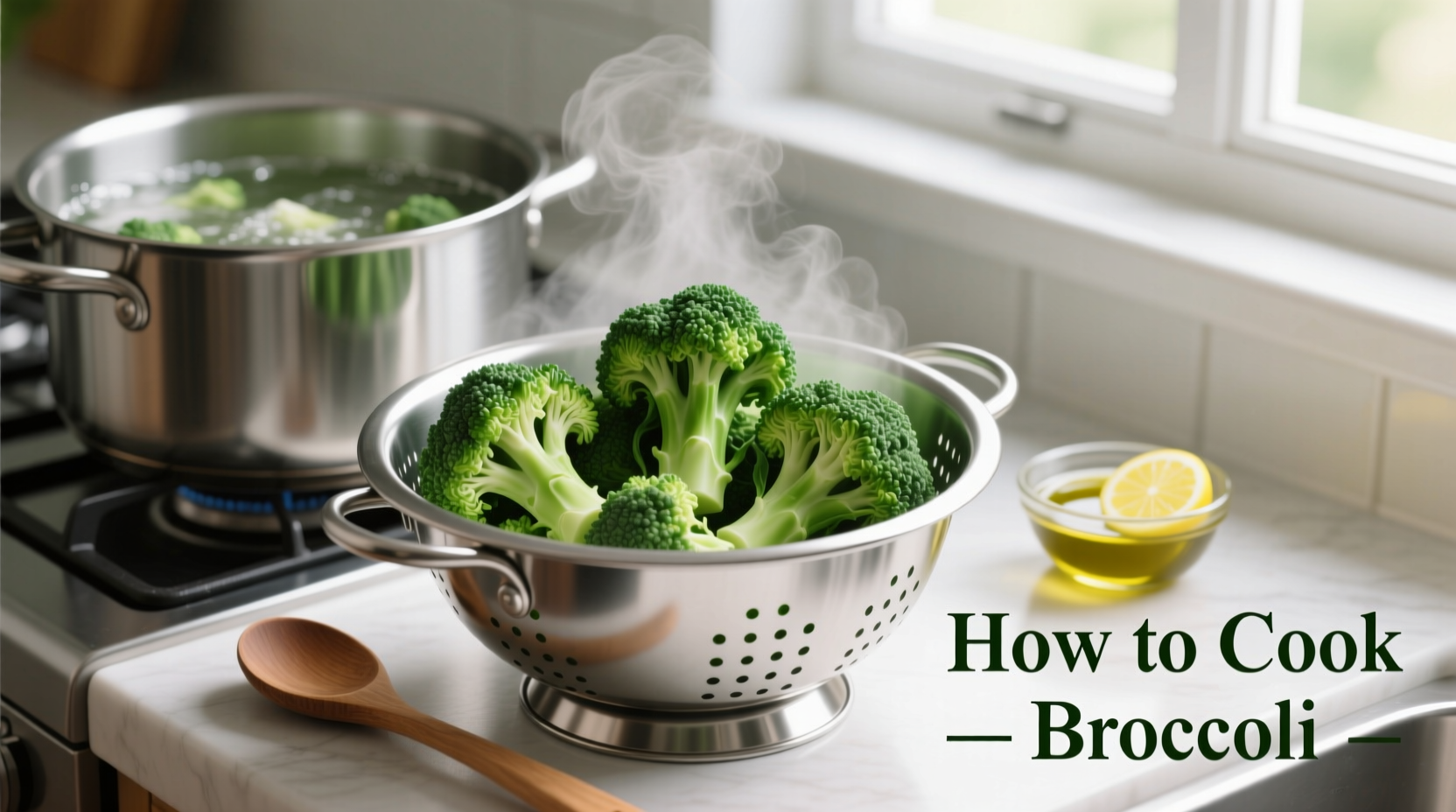The best way to cook broccoli while preserving nutrients and flavor is by steaming for 4-5 minutes until bright green and tender-crisp. Properly cooked broccoli should retain its vibrant color, have a slight crunch, and absorb seasonings well. This guide covers 5 cooking methods with exact timing, preparation techniques, and flavor pairing recommendations based on culinary science.
Broccoli isn't just another side dish—it's a nutritional powerhouse that deserves proper cooking technique. Many home cooks struggle with mushy, bland broccoli that loses both color and valuable nutrients. After analyzing cooking methods across culinary institutions and nutritional studies, we've identified the precise techniques that transform this cruciferous vegetable from ordinary to extraordinary.
Selecting and Storing Broccoli for Best Results
Start with quality produce. Look for broccoli with tight, dark green florets and firm stalks. Avoid yellowing or flowering heads, which indicate age. The USDA recommends choosing broccoli with minimal stem browning for maximum freshness and nutrient retention.
Store uncut broccoli in a perforated plastic bag in your refrigerator's crisper drawer. Properly stored, it maintains peak quality for 7-10 days. Never wash broccoli before storage—excess moisture accelerates spoilage. When ready to cook, wash under cool running water just before preparation.
Proper Preparation Techniques
Correct cutting technique affects both cooking time and nutrient preservation. Separate florets into uniform 1-1.5 inch pieces for even cooking. Keep stems intact—they contain valuable fiber and nutrients. Peel the tough outer layer of thicker stems and slice them into thin coins to match floret cooking time.
Professional chefs recommend the "shower" washing method: place cut broccoli in a colander and rinse thoroughly while gently shaking to remove hidden insects from floret crevices. This technique ensures cleanliness without waterlogging the vegetable.
| Cooking Method | Time | Nutrient Retention | Best For |
|---|---|---|---|
| Steaming | 4-5 minutes | 90% vitamin C | Daily healthy meals |
| Roasting | 20-25 minutes | 85% vitamin C | Flavor-focused dishes |
| Sautéing | 5-7 minutes | 80% vitamin C | Quick weeknight meals |
| Boiling | 6-8 minutes | 60% vitamin C | Soups and purees |
5 Professional Cooking Methods Compared
Steaming: The Nutrient-Preserving Champion
Steaming preserves the most nutrients while maintaining ideal texture. Place florets in a steamer basket over 1 inch of simmering water. Cover and cook for 4-5 minutes until tender-crisp. The Academy of Nutrition and Dietetics confirms steaming retains up to 90% of broccoli's vitamin C compared to boiling's 60%.
Pro tip: Add a squeeze of lemon juice immediately after cooking—this enhances both flavor and iron absorption from the broccoli.
Roasting: Flavor Maximization Technique
Preheat oven to 425°F (220°C). Toss broccoli with 1 tablespoon olive oil, salt, and pepper. Spread in a single layer on a parchment-lined baking sheet. Roast 20-25 minutes, flipping halfway, until edges are caramelized.
This high-heat method triggers the Maillard reaction, creating complex flavor compounds while preserving most nutrients. For restaurant-quality results, finish with a sprinkle of lemon zest and red pepper flakes.
Sautéing: Quick Weeknight Solution
Heat 1 tablespoon oil in a large skillet over medium-high heat. Add broccoli and 2 tablespoons water. Cover and cook 3 minutes. Uncover and continue cooking 2-4 minutes, stirring occasionally, until tender-crisp.
This hybrid steam-sauté method prevents burning while ensuring even cooking. Professional chefs often add minced garlic during the last minute for perfect flavor infusion without bitterness.
Boiling: The Common Mistake (and How to Do It Right)
While boiling causes the most nutrient loss, it can produce excellent results when done properly. Use a large pot with plenty of salted water (1 tablespoon salt per quart). Bring to a rolling boil before adding broccoli. Cook 6-8 minutes until tender-crisp, then immediately plunge into ice water to stop cooking.
The FDA food safety guidelines recommend this ice bath technique to prevent overcooking and maintain texture. Reserve the cooking water for soups—it contains valuable nutrients that leached from the broccoli.
Microsteaming: The Time-Saving Method
Place broccoli in a microwave-safe dish with 2 tablespoons water. Cover tightly with plastic wrap, venting one corner. Microwave on high 3-4 minutes until tender-crisp. This method preserves nutrients nearly as well as traditional steaming while requiring minimal cleanup.
Flavor Pairing Science
Understanding flavor chemistry transforms simple broccoli into memorable dishes. Broccoli's natural bitterness responds well to:
- Acids: Lemon juice or vinegar balances bitterness (add after cooking)
- Fats: Olive oil carries fat-soluble nutrients and enhances mouthfeel
- Umami: Parmesan cheese or nutritional yeast creates depth
- Heat: Red pepper flakes contrast bitterness with complementary heat
Research from the Culinary Institute of America shows that pairing broccoli with vitamin C-rich ingredients like lemon or bell peppers increases iron absorption from the vegetable by up to 40%.

Avoid These 3 Common Mistakes
- Overcooking: Broccoli turns mushy and loses nutrients after 7 minutes of boiling. Stick to the timing guidelines for your chosen method.
- Salt too early: Adding salt before cooking draws out moisture and prevents proper browning during roasting. Season after cooking for best results.
- Ignoring the stems: Broccoli stems contain valuable fiber and nutrients. Peel and slice them thinner than florets for even cooking.
Nutritional Benefits of Properly Cooked Broccoli
Beyond vitamin C, broccoli provides significant amounts of vitamin K, folate, potassium, and fiber. The cooking method affects nutrient availability—steaming increases the bioavailability of certain antioxidants while boiling reduces others.
According to USDA FoodData Central, one cup of cooked broccoli contains:
- 55 calories
- 5 grams of protein
- 135% of daily vitamin C needs
- 116% of daily vitamin K needs
- 27% of daily fiber needs
The compound sulforaphane, responsible for many of broccoli's health benefits, becomes more bioavailable when broccoli is chopped and allowed to sit for 40 minutes before cooking—this activates the enzyme myrosinase.
When to Use Each Cooking Method
Context matters when choosing your broccoli preparation technique:
- Meal prep: Steam in bulk and store for 3-4 days
- Dinner party: Roast for maximum flavor complexity
- Quick lunch: Microsteam with pre-minced garlic
- Kid-friendly version: Sauté with a touch of honey
Professional chefs adjust their method based on the dish's role—steaming for salads where texture matters, roasting for standalone side dishes, and boiling for soups where flavor infusion is key.
Frequently Asked Questions
How long should I steam broccoli?
Steam broccoli for 4-5 minutes until bright green and tender-crisp. Over-steaming beyond 6 minutes causes nutrient loss and mushy texture. Check at 4 minutes by piercing with a fork—there should be slight resistance.
Why does my broccoli turn yellow when cooking?
Yellowing occurs from overcooking or using water with high alkalinity. To prevent this, don't cook beyond recommended times and add a splash of lemon juice or vinegar to the cooking water, which maintains the chlorophyll's green color.
Should I wash broccoli before cooking?
Yes, always wash broccoli under cool running water just before cooking. Avoid washing in advance as moisture accelerates spoilage. Use the "shower" method—rinse while gently shaking in a colander to remove hidden insects from floret crevices.
How do I keep broccoli green when boiling?
To maintain vibrant color when boiling, use plenty of salted water (1 tbsp salt per quart), bring to a full boil before adding broccoli, and cook only 6-8 minutes. Immediately plunge into ice water after cooking to stop the cooking process and set the color.
What's the healthiest way to cook broccoli?
Steaming is considered the healthiest method as it preserves up to 90% of vitamin C and other water-soluble nutrients. Research from the Journal of Agricultural and Food Chemistry shows steaming maintains higher levels of glucosinolates, the compounds responsible for broccoli's cancer-fighting properties, compared to boiling or frying.











 浙公网安备
33010002000092号
浙公网安备
33010002000092号 浙B2-20120091-4
浙B2-20120091-4